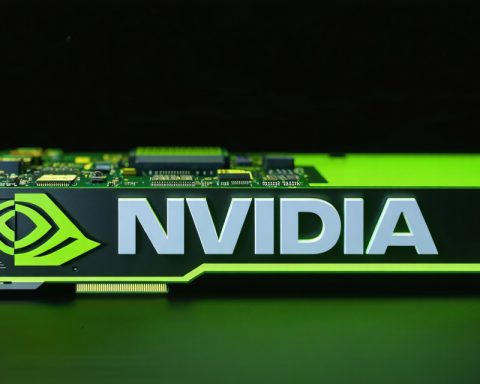- Palantir Technologies and Super Micro Computer are prominent players in the AI sector.
- Despite Palantir’s impressive 36% revenue and 43% clientele growth, its high valuation draws skepticism from analysts.
- Wall Street experts urge caution regarding Palantir’s current stock prices, suggesting they might not reflect long-term viability.
- Super Micro excels in AI server innovation but faces competition from industry giants and unresolved financial reporting issues.
- Investor scrutiny and short seller interest add complexity and uncertainty to Super Micro’s market position.
- Both companies represent high-risk investments; investors should consider potential downturns and not be swayed solely by current growth.
- An informed, prudent investment strategy is crucial in navigating the volatile AI stock market.
In today’s fast-paced world of tech stocks, Palantir Technologies and Super Micro Computer stand out as titans in the AI arena. Yet, ominous forecasts from Wall Street suggest potential pitfalls lurking beyond the allure of their recent successes.
Picture Palantir: a data analytics powerhouse renowned for rapidly transforming prototypes into commercial products. The company boasts impressive accomplishments, with a 36% surge in revenue and a 43% increase in clientele over the past year. However, the stock’s eye-watering valuation, coupled with mixed reviews from industry analysts, casts a shadow over its dazzling performance. Wall Street insiders, like those at RBC Capital, urge caution, suggesting that today’s hype may not justify the eye-popping price multiples.
Over at Super Micro, the picture isn’t any greener. Known for its agility in bringing new server technology to market, Super Micro’s embrace of innovation has made it a leader in AI servers. But as the industry landscape evolves, questions arise about its unique advantages—or lack thereof—against titans like Dell. Meanwhile, unresolved financial reporting issues further muddy the waters. The short seller scrutiny adds another layer of uncertainty, leaving current investors with more questions than answers.
So, what’s the takeaway? For those captivated by the allure of AI stocks, a prudent approach may be warranted. These two industry leaders, while presently shining bright, navigate a path fraught with potential downturns. Before jumping on the bandwagon, investors might want to meticulously weigh the risks, ensuring that their portfolios don’t lean too heavily on stocks that could soon face a downturn. Stay informed, stay vigilant, and remember: not all that glitters is gold.
AI Stocks: Golden Opportunity or Glimmering Risk?
How-To Steps & Life Hacks: Investing in AI Stocks
1. Research the Companies: Look beyond financial performance. Investigate business models, leadership, competitive edge, and industry positions.
2. Assess Financial Health: Scrutinize revenue growth, profit margins, and cash flow. For Palantir, pay attention to R&D spending and customer acquisition strategies.
3. Understand Valuations: Compare stock price to earnings and sales. Keep an eye on Palantir’s high price multiples and how they align with growth promises.
4. Diversify Your Portfolio: Avoid heavy reliance on AI stocks despite their allure. Balance risk by investing in varying sectors.
5. Long-Term View: Analyze market trends, such as AI’s adoption rate, regulatory changes, and potential technological disruptions.
Real-World Use Cases
– Palantir Technologies: Known for its powerful data analytics software, Palantir finds its use in intelligence, defense, and commercial sectors. Governments use it for anti-terrorism operations, while corporations optimize supply chains and risk management.
– Super Micro Computer: As a leader in AI server technology, their use cases span from data centers to cloud infrastructure, empowering companies running complex AI models.
Market Forecasts & Industry Trends
– AI Growth: The AI market is predicted to grow by nearly 40% annually over the next few years, reaching a value of approximately $300 billion by 2026. Companies like Palantir and Super Micro are positioned to capitalize on this growth (source: Gartner).
– AI in Hardware: Super Micro could benefit as AI workloads demand more powerful hardware, with quantum computing and advanced GPUs being potential areas of growth.
Reviews & Comparisons
– Palantir vs. IBM: While Palantir excels in complex data integration and analytics, IBM has a broader portfolio, including AI-infused cloud services.
– Super Micro vs. Dell: Dell offers comprehensive solutions and branding, while Super Micro provides cost-effective, customizable server solutions.
Controversies & Limitations
– Palantir: Criticized for lack of transparency and privacy concerns. Its government affiliations, especially in defense, have drawn scrutiny.
– Super Micro: Faces scrutiny over financial reporting and accounting practices, raising red flags among investors.
Features, Specs & Pricing
– Palantir: Offers Foundry, Gotham, and Apollo platforms. Pricing is subscription-based and variable depending on usage and services.
– Super Micro: Specializes in customizable AI servers, geared towards enterprise needs. Pricing depends on configuration, typically higher for AI-optimized units.
Security & Sustainability
– Palantir: Invests heavily in data security, crucial for its clientele in defense and finance. However, sustainability initiatives are rarely highlighted.
– Super Micro: Needs to focus more on energy-efficient server technology to meet sustainability mandates.
Insights & Predictions
– Palantir: Likely to pivot its focus towards more commercial clients to supplement government contracts.
– Super Micro: Expected to innovate in edge computing, catering to growing IoT demands.
Pros & Cons Overview
– Palantir Pros: Strong government contracts, advanced analytics capabilities.
– Palantir Cons: High valuation, potential regulatory scrutiny.
– Super Micro Pros: Innovation in AI technology, cost-effective solutions.
– Super Micro Cons: Financial transparency issues, competitive threats.
Actionable Recommendations
– Stay Informed: Regularly review news sources like Bloomberg and CNBC for the latest industry developments.
– Diversify Investments: Balance tech stocks with stable sectors like consumer goods or healthcare.
– Patience and Caution: Stay updated on regulatory changes impacting AI and tech sectors.
Engage with these insights for a smarter investment strategy, ensuring your financial decisions are rooted in thorough research and strategic foresight.












